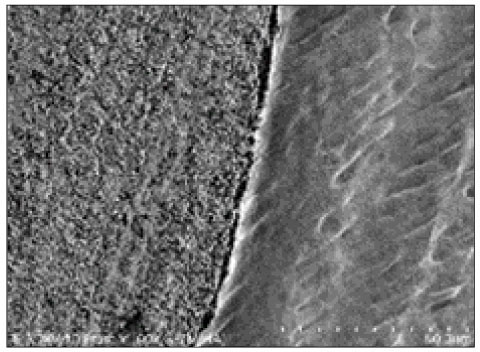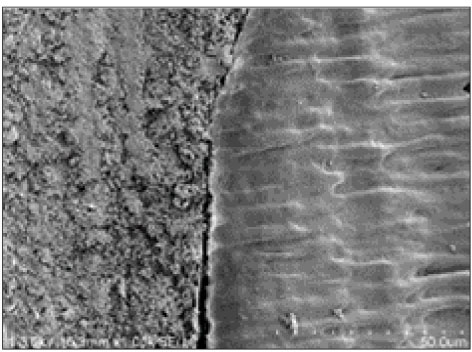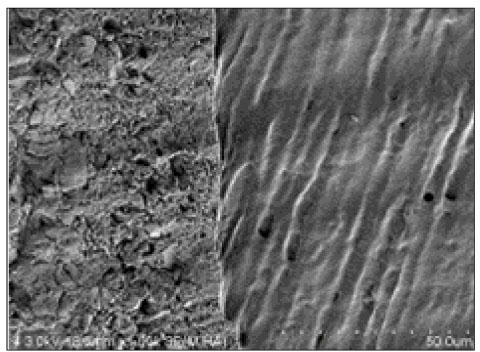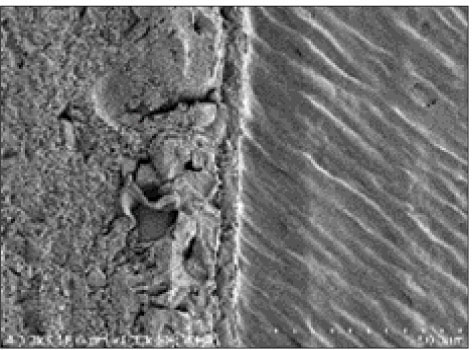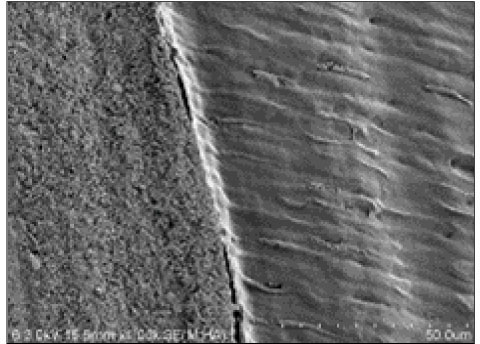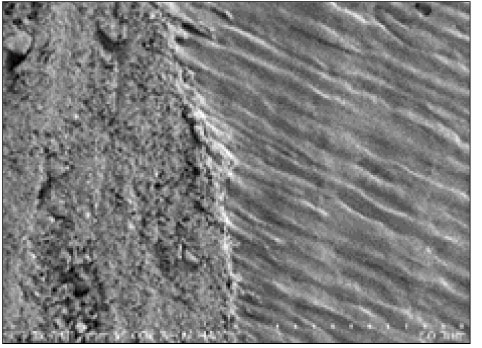J Korean Acad Conserv Dent.
2009 May;34(3):223-231. 10.5395/JKACD.2009.34.3.223.
Effect of a desensitizer on dentinal bond strength in cementation of composite resin inlay
- Affiliations
-
- 1Department of Conservative Dentistry, Dental Center, Chung Ang University Hospital, Korea.
- 2Department of Conservative Dentistry, College of Dentistry, Chosun University, Korea. ygcho@chosun.ac.kr
- KMID: 2176148
- DOI: http://doi.org/10.5395/JKACD.2009.34.3.223
Abstract
- The purpose of this study was to evaluate the effect of a desensitizer on dentinal bond strength in cementation of composite resin inlay. Fifty four molar teeth were exposed the occlusal dentin. Class I inlay cavities were prepared and randomly divided into six groups. Control group ; no agent, Group 1 ; Isodan, Group 2 ; One-step, Group 3 ; All-Bond SE, Group 4 ; Isodan + One-step, Group 5 ; Isodan + All-Bond SE. Desensitizing agent and dentin bonding agents were applied immediately after the completion of the preparations. Impressions were then made. The composite resin inlays (Tescera, Bisco) were fabricated according to the manufacturers' guidelines. Cementation procedures followed a standard protocol by using resin cement (Bis-Cem, Bisco). Specimens were stored in distilled water at 37degrees C for 24 hours. All specimens were sectioned to obtained sticks with 1.0 x 1.0 mm2 cross sectional area. The microtensile bond strength (microTBS) was tested at crosshead speed of 1 mm/min. The data was analyzed using oneway ANOVA and Tukey's test. Scanning electron microscopy analysis was made to examine the details of the bonding interface. 1. Group 1 showed significantly lower microTBS than other groups (p<0.05). 2. There was no significant difference between the microTBS of Group 3 and Group 5. 3. The microTBS of Group 4 showed significantly lower than that of Group 2 (p<0.05). In conclusion, a desensitizer (Isodan) might have an adverse effect on the bond strength of composite resin inlay to dentin.
Keyword
MeSH Terms
Figure
Cited by 1 articles
-
Microtensile bond strength of self-etching and self-adhesive resin cements to dentin and indirect composite resin
Jae-Gu Park, Young-Gon Cho, Il-Sin Kim
J Korean Acad Conserv Dent. 2010;35(2):106-115. doi: 10.5395/JKACD.2010.35.2.106.
Reference
-
1. Song MH, Park SJ, Jo HG, Hwang YC, Oh OM, Hwang IN. Influence of adhesive application on shear bond strength of the resin cement to indirect resin composite. J Korean Acad Conserv Dent. 2008. 33(5):419–426.
Article2. Kim DS, Park SH, Choi KY, Choi KK, The Effect. The Effect of Bonding Resin on Bond Strength of Dual-Cure Resin Cements. J Korean Acad Conserv Dent. 2007. 32(5):426–436.
Article3. Jo MW, Park SH, Kim JR, Choi KK. The bonding durability of resin cements. J Korean Acad Conserv Dent. 2007. 32(4):343–353.
Article4. Radovic I, Coniglio I, Magni E, Carvalho CA, Ferrari M. Luting fiber posts with self-adhesive cements: A push-out bond strength test. J Dent Res Appl. 2007. 1(1):50–55.5. Abo-Hamar SE, Hiller KA, Jung H, Federlin M, Friedl KH, Schmalz G. Bond strength of a new universal self-adhesive resin luting cement to dentin and enamel. Clin Oral Investig. 2005. 9:161–167.
Article6. Christensen GJ. Resin cements and postoperarive sensitivity. JADA. 2000. 131:1197–1199.7. Unemori M, Matsuya Y, Akashi A, Goto Y, Akamine A. Composite resin restoration and postoperative sensitivity clinical follow-up in an undergraduate program. J Dent. 2001. 29:7–13.
Article8. Opdam NJM, Roeters FJM, Feilzer AJ, Verdonschot EH. Marginal integrity and postoperative sensitivity in Class 2 resin composite restorations in vivo. J Dent. 1998. 26:555–562.
Article9. Jo YG, Ban IH, Yu MK. The chance of adaptability chance in adhesive systems to dentin substrte according to storage time. J Korean Acad Conserv Dent. 2005. 30(3):204–214.
Article10. Tay FR, Hashimoto M, Pashley DH, Peters MC, Lay SC, Yiu CK, Cheong C. Aging affects two modes of nanoleakage expression in bonded dentin. J Dent Res. 2003. 82(7):537–541.
Article11. Ozturk N, Aykent F. Dentin bond strengths of two ceramic inlay systems after cementation with three different techniques and one bonding system. J Prosthet Dent. 2003. 89:275–281.
Article12. Magne P, Kim TH, Cascione D, Donovan TE. Immediate dentin sealing improves bond strength of indirect restorations. J Prosthet Dent. 2005. 94:511–519.
Article13. Magne P, So WS, Cascione D. Immediate dentin sealing supports delayed restoration placement. J Prosthet Dent. 2007. 98(3):166–174.
Article14. Jayasooriya PR, Pereira PN, Nikaido T, Tagami J. Efficacy of a resin coating on bond strengths of resin cement to dentin. J Esthet Restor Dent. 2003. 15(2):105–113.
Article15. Sengun A, Koyuturk AE, Sener Y, Ozer F. Effect of densensitizers on the bond strength of a self-etching adhesive system to careis-affected dentin on the gingival wall. Oper Dent. 2005. 30(4):430–435.16. Omae M, Inoue M, Itota T, Finger WJ, Inoue M, Tanaka K, Yamamoto K, Yoshiyama M. Effect of a desensitizing agent containing glutaraldehyde and HEMA on bond strength to Er:YAG laser-irradiated dentin. J Dent. 2007. 35:398–402.
Article17. Akca T, Yazici AR, Celik C, Ozgunaltay G, Dayabgac B. The effects of desensitizing treatments on the bond strength of resin composite to dentin mediated by a self-etching primer. Oper Dent. 2007. 32(5):451–456.
Article18. Brackett WW, Tay FR, Brackett MG, Dib A, Sword RJ, Pashley DH. The effects of chlorhexidine on dentin hybrid layers In Vivo. Oper Dent. 2007. 32(2):107–111.19. Craig RG. Overview of posterior composite resin for use in clinical practice in Vanherle G Smith DC(eds). Posterior Composite Resin Dental Restorative Materials. 1985. St.Paul: 3M Co;199–211.20. Christensen GJ. Acceptability of alternatives for conservative restoration of posterior teeth. J Esthet Dent. 1995. 7:228–232.
Article21. Douglas WH, Fields RP, Fundingsland J. A comparison between the microleakage of direct and indirect composite restorative systems. J Dent. 1989. 17:184–188.
Article22. Technical data sheet : Espertise Rely X Unicem. 2002. Seefeld Germany: 3M ESPE.23. Suh BI. New strategies in Adhesive Dentistry : All-Bond 3 and All-Bond SE. J Dent Res Appl. 2007. 1(1):2–6.24. Christensen GJ. Preventing postoperative tooth sensitivity in Class I, II and V restorations. JADA. 2002. 133:229–231.
Article25. Paul SJ, Scharer P. The dual bonding technique : a modified to improve adhesive luting procedures. Int J Periodontics Restorative Dent. 1997. 17:536–536.26. Aranha ACC, Siqueira Junior CA, Cavalcante LMA, Pimenta LAF, Marchi GM. Microtensile bond strengths of composite to dentin treated with densensitizer products. J Adhes Dent. 2006. 8:85–90.27. Yiu CKY, King NM, Suh BI, Sharp LJ, Carvalho RM, Pashley DH, Tay FR. Incompatibility of oxalate densensitizers with acidic, fluoride-containing total-etch adhesives. J Dent Res. 2005. 84(8):730–735.
Article28. Fu B, Shen Y, Wang H, Hanning M. Sealing ability of dentin adhesives /densensitizer. Oper Dent. 2007. 32(5):496–503.
- Full Text Links
- Actions
-
Cited
- CITED
-
- Close
- Share
- Similar articles
-
- The Effect Of Temporary Cement And Desensitizer On The Bond Strength Of Luting Cements
- Effect Of Dentin Desensitizers On Shear Bond Strength Of Resin Cements
- SHEAR BOND STRENGTH OF LUTING CEMENTS TO DENTIN TREATED WITH RESIN BONDING AGENTS
- Effect of the additional etching procedure on push-out bond strength of one-step resin cement
- Influence of adhesive application on shear bond strength of the resin cement to indirect resin composite

